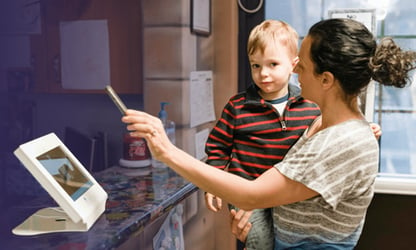 As adults, we can actively seek out knowledge and information that makes us better equipped to form meaningful connections with other people from different backgrounds. However, kids rely on adults to instill these skills and a sense of respect for diversity. This is true for all adults in a student's life, including family, teachers, coaches and staff.
As adults, we can actively seek out knowledge and information that makes us better equipped to form meaningful connections with other people from different backgrounds. However, kids rely on adults to instill these skills and a sense of respect for diversity. This is true for all adults in a student's life, including family, teachers, coaches and staff.
Unfortunately, it can be challenging to promote diversity in a child care setting. Students aren’t often equipped with the skills necessary to address diversity tactfully. This can lead to unintentional disrespect or insults. Moreover, many child care programs lack a diverse staff and student body. Regardless of the challenges faced by promoting diversity in your program, it remains a vital task.
Unsure of where to start? This guide will breakdown everything you need to know about how to respect and promote diversity in your child care program.
What is Diversity and Why is it Important?
Diversity is a term that encompasses all the aspects of identity that make an individual unique. It includes characteristics such as age, sexual orientation, gender, nationality, culture, disability and race. The promotion of diversity is an effort to enhance and increase diversity in a given environment.
There are many ways to achieve this goal, but it starts with welcoming people from different backgrounds and respecting their identity. These two foundations are critical to the facilitation of meaningful relationships and connections between all individuals. However, meaningful connections aren’t the only advantages of diversity.
Diversity offers a range of benefits in any setting. For kids, these benefits are a bit more distinct. The benefits of diversity in your child care program include:
- Increased creativity and innovation: In a diverse setting, students can leverage their classmates’ different backgrounds and experiences to find creative solutions to problems.
- Nurturing empathy: A known empathy gap arises when children and teens meet others outside of those that share fundamental aspects of their identity. Exposing students to diversity enables them to overcome this empathy gap sooner rather than later.
- Preparation for future diverse settings in adulthood: Our students don’t stay young forever. As they grow, they will likely encounter an increased number of people with different backgrounds, especially as they go on to college or enter the workforce. Respecting diversity provides students with crucial preparation for the future.
Overall, diversity is essential and unavoidable. Understanding the value of different perspectives, backgrounds, and experiences can be challenging for students. However, it’s a critical skill, one that can lead to lifelong friendships and mutual respect.
Promoting Diversity in a Child Care Program
Diversity has always been a treasured aspect of America’s portrait. The U.S. is home to unique individuals spanning a wide range of cultures, ethnicities, nationalities and more. However, the idea of America as a “melting pot” of diversity fails to acknowledge the challenges to diversity that the country needs to work to overcome.
Current efforts to promote diversity and inclusion have become a driving force of change across the country. Child care programs are working to implement changes that demonstrate their dedication to promoting diversity and inclusion. However, it can be difficult to choose strategies that are effective and positive. Here are some of the most effective ways to promote diversity in a child care program if you need guidance.
Create an Environment That Reflects Diversity
Child care environments encompass everything from the posters on the wall to materials on shelves. All of these materials should be carefully chosen to promote healthy development, learning and diversity. However, it can be hard to find materials that promote diversity. So, you’ll need to take some additional time to find the best materials.
If you’re unsure about whether your learning environment reflects and promotes diversity, there are many tools available to help. This worksheet provides an excellent questionnaire to help child care managers and staff determine whether they have made a significant effort to create an environment that promotes diversity.
Choose Activities that Promote Diversity
There are many ways to teach students about diversity. Some of the best (and fun!) ways to teach diversity is by creating activities that help kids experience it. While you may not be able take a class trip to another country, you can make it your mission to promote a curriculum that includes learning about other cultures and peoples. Here are some activities that offer great strategies on how to promote diversity.
- Storytime: When stocking your classroom with books, be sure to include diverse book selections. Start by looking for books with characters of color from different backgrounds, or that explore different cultures. This website provides a detailed list of culturally diverse books and where to find them. Start your search there!
- Celebrate Student Diversity: Work with parents to help children create a presentation of their culture. This allows children to learn about their peers' different cultures.
- Set Up a Travel Station: Specifically for young children, the idea of a global world filled with many different cultures and peoples can be difficult to grasp. You can help young students understand this better by creating a global travel station where children can “visit” a different country and learn about its culture. Update this station with new countries throughout the year.
Acknowledge and Respect Cultural Diversity
Acknowledging and respecting diversity is an integral aspect of diversity and inclusion efforts, even in your child care program. A person's culture can greatly impact their lives, including how they dress, social interactions, holiday celebrations and various practices. Teaching about cultural diversity can help kids better understand and respect another person’s culture.
Reaching out to families and the local community can help to promote cultural diversity in child care. These volunteers can give information about the different cultures represented in the students and staff. With this information, you can work to acknowledge and respect cultural diversity within your program. As a start, be sure to include celebrations that go beyond traditional American holidays. Teach children about Kwanzaa, Eid, Hanukkah and Christmas!
Key Takeaways
While child care programs might not seem like a hotbed of diversity celebrations, there’s no reason they shouldn’t be! Taking the time to educate and inform kids about different cultures and the diversity that exists today is critical.
This education helps to nurture their sense of respect and understanding of people from different backgrounds. Moreover, it can give students an outlet to explore various cultures outside of their own. Though it can be challenging, respecting and promoting diversity has a host of benefits. The most important is laying the foundation for a global citizen.
Discover the Secrets to Simpler Child Care Program Management!
Download our free eBook with expert tips that will not only help you improve your child care program, but show you how to simplify its management, so you and your team can enjoy a much needed breather.










.jpg?width=450&height=250&name=34-K-12-School-Templates_thumbnail%20(1).jpg)



